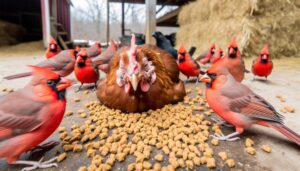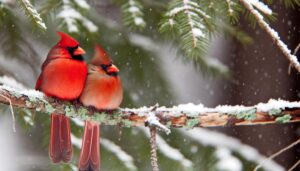Do Cardinals Fly South for Winter or Stay Put?
No, cardinals don't fly south for the winter. They are non-migratory birds and adapt to seasonal changes within their habitat.
Cardinals fluff their feathers for insulation and seek shelter in dense shrubs and trees. Their dynamic foraging methods, including ground foraging and shrub hopping, help them find food sources like seeds, berries, and small insects.
These birds are highly adaptable to colder climates and remain in their range from Canada through Central America. Their survival depends on their resourcefulness in the harsh winter months.
Learn more about how their behaviors and habitats support their year-round residence.
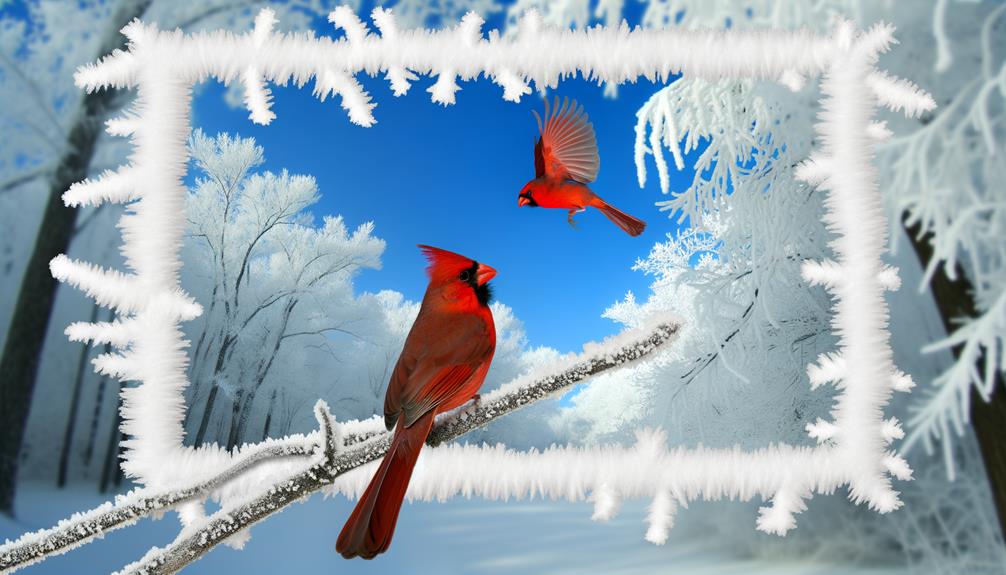
Key Takeaways
- Cardinals are non-migratory and typically do not fly south for the winter.
- They adapt to seasonal changes by utilizing local resources year-round.
- Cardinals rely on diverse food sources like seeds, berries, and insects during winter.
- They use strategies like feather fluffing and seeking dense shrubs for insulation.
- Cardinals prefer temperate zones with ample tree cover and shrubbery for year-round habitat stability.
Cardinal Migration Patterns
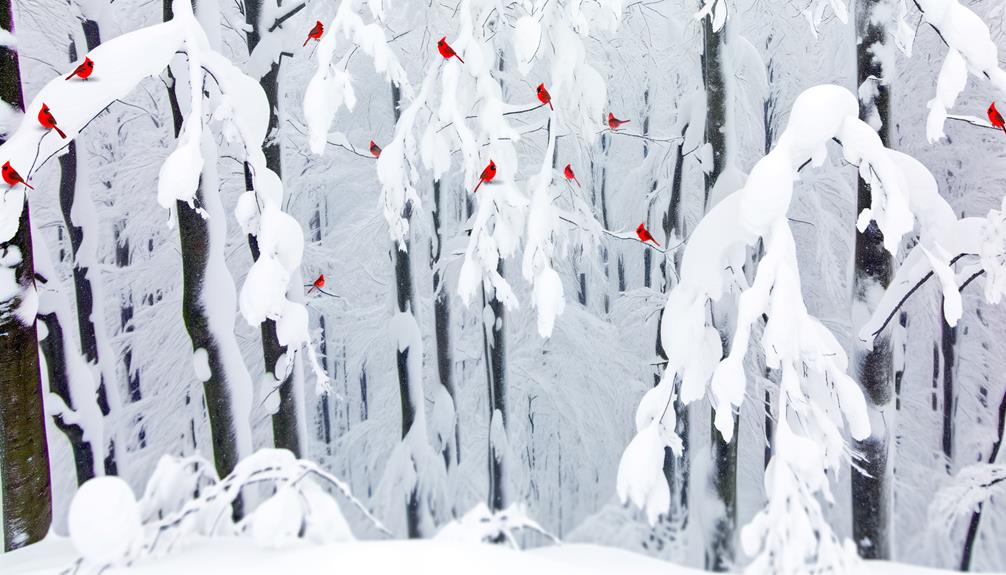
Cardinal migration patterns are particularly distinctive because these birds typically don't migrate and stay within their range year-round. Unlike many avian species, cardinals exhibit a strong territorial behavior, maintaining their ranges even during harsh winters.
You'll find that their range spans from Canada through Central America. Cardinals prefer dense, shrubby habitats and deciduous forests, providing ample cover and food sources throughout the year. Their non-migratory nature means they rely on local resources and adapt to seasonal changes.
Winter Survival Strategies
By leveraging their adaptive behaviors and resourcefulness, these resilient birds endure the winter months through various survival strategies.
You'll find that cardinals employ several techniques to cope with the cold.
- Feather Fluffing: Cardinals fluff their feathers to create air pockets for better insulation, trapping body heat.
- Shelter Seeking: They seek dense shrubs, evergreen trees, or man-made structures to protect against harsh winds and snow.
- Pair Bonding: During winter, cardinals often form pairs which helps in mutual grooming and warmth sharing.
These strategies are essential for their survival and demonstrate their remarkable adaptability.
Food Sources in Winter
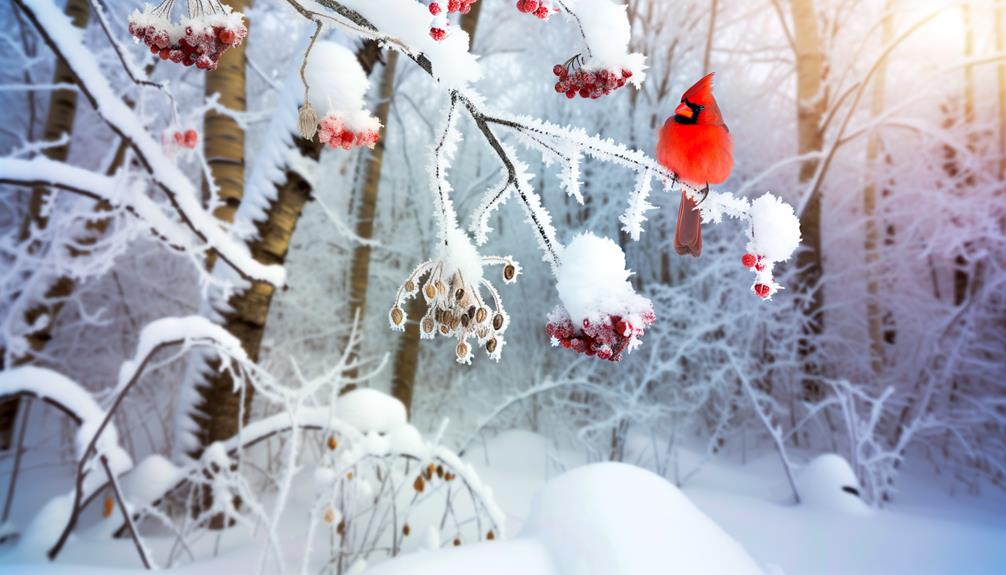
In addition to their survival strategies, cardinals exhibit remarkable foraging behaviors to secure food sources throughout the winter months. You'll notice they rely on diverse food sources, such as seeds, berries, and small insects. They're particularly adept at seeking out food in various environments, from backyard feeders to natural habitats.
Here's a detailed breakdown of their winter diet:
| Food Source | Nutritional Value | Foraging Method |
|---|---|---|
| Sunflower Seeds | High in fat | Ground foraging |
| Berries | Rich in vitamins | Shrub hopping |
| Small Insects | Protein-rich | Bark pecking |
| Safflower Seeds | High in protein | Feeder visiting |
| Cracked Corn | Carbohydrate-rich | Ground pecking |
These behaviors guarantee cardinals maintain their energy levels, essential for winter survival.
Habitat Preferences
When considering habitat preferences, you'll find that cardinals favor temperate climate zones with ample tree cover and shrubbery.
These birds have adapted regionally to withstand varying winter conditions, often staying in areas with sufficient food and shelter.
Understanding these preferences helps explain their limited migration patterns.
Preferred Climate Zones
Have you ever wondered why cardinals prefer temperate regions over tropical climates for their year-round habitat? Cardinals thrive in temperate zones due to several key factors that enhance their survival and reproduction.
These regions offer:
- Seasonal Variation: Temperate climates provide a balance of warm and cold seasons, which helps regulate food availability and breeding cycles.
- Vegetation Diversity: A variety of plants and trees in these areas supports their diet of seeds, fruits, and insects.
- Habitat Stability: Less drastic weather changes compared to tropical climates offer more stable nesting sites and protection from predators.
Understanding these preferences helps you appreciate why cardinals choose temperate zones, where they find ideal conditions for their lifestyle and growth.
Regional Adaptations
Cardinals exhibit remarkable behavioral and physiological adaptations that allow them to thrive in diverse regional habitats across North America. You'll find these birds in deciduous forests, swamps, and even suburban gardens. They prefer areas with dense shrubbery for cover and nesting.
Cardinals don't migrate, relying instead on their ability to withstand varying temperatures. In colder regions, they fluff their feathers to trap heat and forage for high-energy food sources such as seeds and berries. Their vibrant red plumage provides an advantage in attracting mates, even in snowy landscapes.
Role of Climate
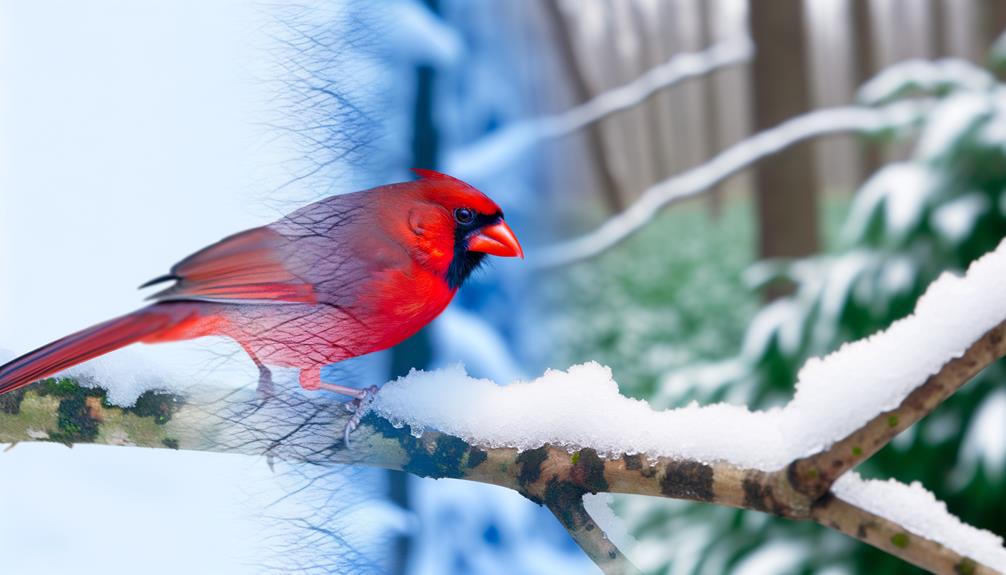
You need to contemplate how temperature impacts cardinals' migration patterns and their ability to adapt seasonally.
Cardinals often remain in their habitats year-round due to their capacity to withstand colder climates. They employ various strategies like altering their diet and seeking shelter to survive winter conditions.
Temperature Effects on Migration
Understanding how temperature influences bird migration is essential to comprehending the role climate plays in dictating the seasonal movements of cardinals.
You need to recognize that cardinals, unlike many other birds, don't typically migrate. However, temperature changes impact their behavior and habitat preferences.
Here's how:
- Food Availability: Lower temperatures reduce food sources, forcing cardinals to adapt their foraging strategies.
- Thermoregulation: Cold weather demands more energy for maintaining body heat, influencing their daily activities and energy expenditure.
- Habitat Selection: Cardinals may shift to microhabitats offering better shelter and food during colder months.
Seasonal Adaptation Strategies
Adapting to seasonal changes, these resilient birds employ various strategies to cope with the challenges posed by fluctuating climates. You'll find cardinals altering their behavior to maximize survival. They grow denser plumage to insulate against the cold. By fluffing up their feathers, they trap air, creating a thermal barrier.
Cardinals also change their diet, consuming more seeds and berries, which are high in energy and more readily available in colder weather. They'll even forage in groups to increase efficiency and reduce predation risk. Additionally, cardinals might seek shelter in dense shrubs or evergreen trees, providing protection from harsh winds and predators.
These adaptive strategies allow cardinals to remain non-migratory, thriving despite the seasonal shifts in their environment.
Comparing With Other Birds
In contrast to migratory species like the American Robin, cardinals exhibit a year-round residency within their range, showcasing their unique adaptation to colder climates. Unlike other birds that migrate to warmer areas to escape harsh winters, cardinals remain in their habitats due to their ability to find food and shelter even in snowy conditions. This non-migratory behavior allows you to observe their vibrant plumage throughout the year.
Here are three reasons why cardinals stay put while other birds migrate:
- Diet Adaptability: Cardinals can switch from insects to seeds and berries.
- Thick Plumage: Their feathers provide insulation against cold temperatures.
- Territorial Behavior: They maintain and defend their territories year-round.
This resilience highlights their distinct survival strategies.
Observing Cardinals in Winter
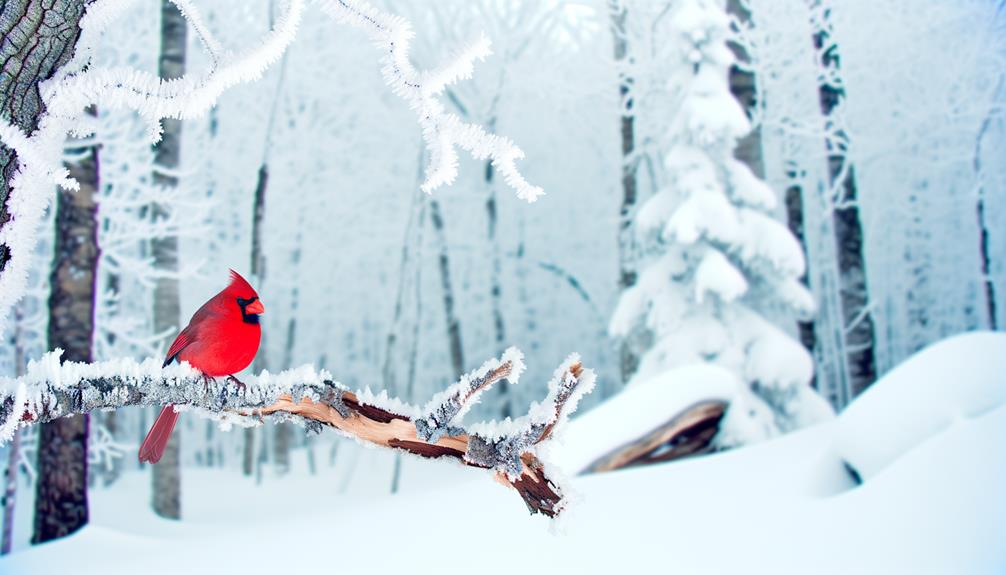
Have you ever wondered how cardinals' vibrant red feathers stand out even more against a snowy winter landscape?
When you observe cardinals in winter, you'll notice they don't migrate. They're year-round residents, adapting to cold temperatures by fluffing their feathers to trap heat.
To spot them, look near dense shrubs and evergreen trees where they seek shelter and food. You can attract them to your yard by providing sunflower seeds and suet.
Their striking color contrasts sharply against the white snow, offering a unique opportunity for birdwatching and photography.
Monitoring their behavior and feeding patterns during winter can provide insights into their survival strategies, enhancing your appreciation for these resilient birds.
Conclusion
You might think cardinals, like many birds, would flee south to escape winter's grip.
But, here's the twist: they don't. Cardinals have adapted impressive strategies to tough it out. They rely on ample food sources, choose sheltered habitats, and even adjust their behavior.
Climate unquestionably plays a role, but these resilient birds have found ways to thrive.
So, next time the snow falls, look closely—you just might spot a cardinal braving the cold right in your backyard.

